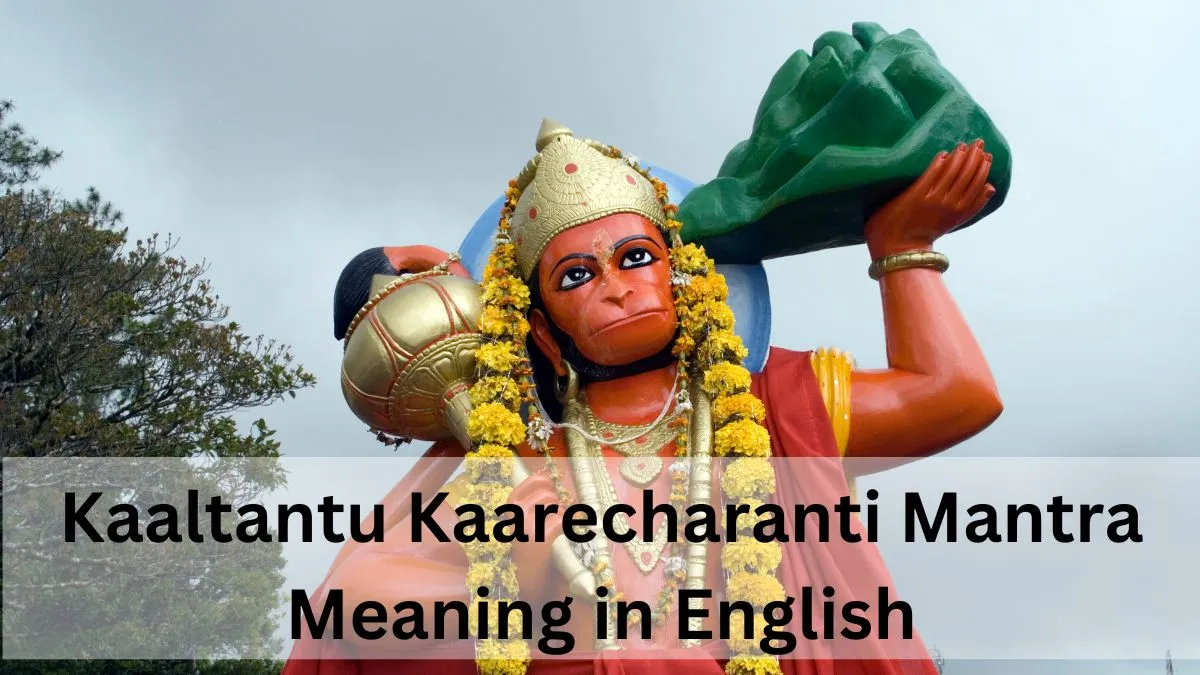kaaltantu kaarecharanti mantra meaning | kaaltantu kaarecharanti mantra meaning in english | kaaltantu kaarecharanti enar marishnu mantra meaning | kaaltantu kaarecharanti enar marishnu mantra meaning in emglish | kaaltantu kaarecharanti enar marishnu nirmukter kaaletwam amarishnu | kaaltantu kaarecharanti enar marishnu nirmukter kaaletwam amarishnu meaning | kaaltantu kaarecharanti enar marishnu nirmukter kaaletwam amarishnu meaning in english | कालतंतु कारेचरन्ति एनर मरिष्णु निर्मुक्तेर कालेत्वम अमरिष्णु meaning in english
Kaaltantu Kaarecharanti Mantra Meaning in English
Kaaltantu Kaarecharanti Mantra Meaning : The mantra “kaaltantu kaarecharanti enar marishnu nirmukter kaaletwam amarishnu” serves as a profound meditation on the interplay between time, mortality, and immortality in the context of Hindu philosophy.
In our Hindu religion it is said that Hanuman ji is the only god who is still present on this earth, he has taken shelter in the Himalayan forests and whoever calls him with true heart by chanting this mantra, He definitely gives darshan. If his devotees are ever in any trouble, he definitely comes to help them.
You will hardly believe it, but at many places, greetings have been found which prove that Hanuman ji is still present on this earth. Footprints of Hanuman ji can be seen at many places on this earth.
Read Also: Om Shri Vardhanaya Namah Benefits
There is a community in Sri Lanka which keeps itself away from this modern world and invokes Lord Hanuman according to the worship method prescribed in Hindu religion.
This mantra of Hanuman ji proves to be effective only when you chant it with full devotion and true heart, and on the day you chant this mantra, no wrong has been done by you. Along with this, you have to chant this mantra at a place away from the worldly world in which no other human being is present within a radius of 980 meters.
There is a popular story that Hanuman ji had given this mantra as a boon to the ancestors of a special wild tribe living on the Piduru mountain of Piduruthalagala in Sri Lanka.
It is said that after the departure of Lord Shri Ram, Hanuman ji had taken shelter in the forests under the rule of Vibhisan where this tribe served him and being pleased with them, he gave him this mantra as a boon and said Whenever you want to have my darshan, chant this mantra and I will come with the speed of the wind.
However, so that no one can misuse this mantra, he made some conditions which we told you above.
It invites individuals to contemplate the impermanence of the physical body, the enduring nature of the soul, and the possibility of transcending the cycle of birth and death to attain ultimate liberation and immortality.
This mantra encapsulates the timeless wisdom of ancient Indian thought, offering seekers a path towards profound spiritual realization and eternal truth.
Read Also: Om Shri Vardhanaya Namah Meaning
Kaaltantu Kaarecharanti Mantra in English
“Kaaltantu Kaarecharanti Enar Marishnu Nirmukter Kaaletwam Amarishnu“
Kaaltantu Kaarecharanti Mantra Meaning in English
The mantra “kaaltantu kaarecharanti enar marishnu nirmukter kaaletwam amarishnu” is a complex and enigmatic phrase in Sanskrit. Its meaning can be explored in detail by breaking down each word and its significance:
1) Kaaltantu: This word comprises two parts – “kaala” and “tantu.”
* Kaala represents time, not just in a linear sense but as a cyclical and all-encompassing force in Hindu cosmology. It symbolizes the eternal cycle of creation, preservation, and destruction.
* Tantu can be translated as thread or string. In this context, it alludes to the interconnectedness of all things in the fabric of time.
➤ So, “kaaltantu” suggests the interconnectedness of all existence within the framework of time.
2) Kaarecharanti: This word also consists of two components – “kaar” and “charanti.”
* Kaar refers to actions or deeds.
* Charanti implies movements or occurrences.
➤ Therefore, “kaarecharanti” signifies the continuous flow of actions and events in the course of time.
3) Enar: This term is often interpreted as “Ena” followed by “ar.”
* Ena is akin to “this” or “that,” indicating a sense of particularity.
* Ar is a particle that can suggest emphasis or certainty.
➤ In the context of the mantra, “enar” can be understood as emphasizing the specificity or particularity of the subject matter.
4) Marishnu: This word is derived from “mara” and “ishnu.”
* Mara denotes mortality or death.
* Ishnu relates to the desire for or the pursuit of something.
➤ Thus, “marishnu” suggests the pursuit or desire for immortality in the face of mortality.
5) Nirmukter: This term is derived from “nir” and “mukti.”
* Nir signifies negation or absence.
* Mukti translates to liberation or freedom from the cycle of birth and death (samsara).
➤ “Nirmukter” implies the state of being free from the cycle of reincarnation or achieving liberation.
6) Kaaletwam: This word combines “kaala” and “twam.”
* Kaala, as mentioned earlier, represents time.
* Twam means “you” or “yourself.”
➤ Therefore, “kaaletwam” conveys the idea of yourself or your existence within the realm of time.
7) Amarishnu: Similar to “marishnu,” this word is composed of “amara” and “ishnu.”
* Amara signifies immortality or that which is not subject to death.
* Ishnu again relates to the desire for or pursuit of something.
➤ “Amarishnu” signifies the pursuit or desire for immortality, but in this case, it refers to the attainment of true immortality beyond the cycle of birth and death.
Conclusion
The mantra “kaaltantu kaarecharanti enar marishnu nirmukter kaaletwam amarishnu” invites deep contemplation on the interplay between time, mortality, and the pursuit of immortality.
It emphasizes the interconnectedness of all existence within the framework of time, the ceaseless flow of actions and events, and the quest for ultimate liberation and true immortality beyond the cycle of birth and death.
This mantra encapsulates profound philosophical and spiritual insights, challenging practitioners to explore the nature of existence and the pursuit of transcendence.
